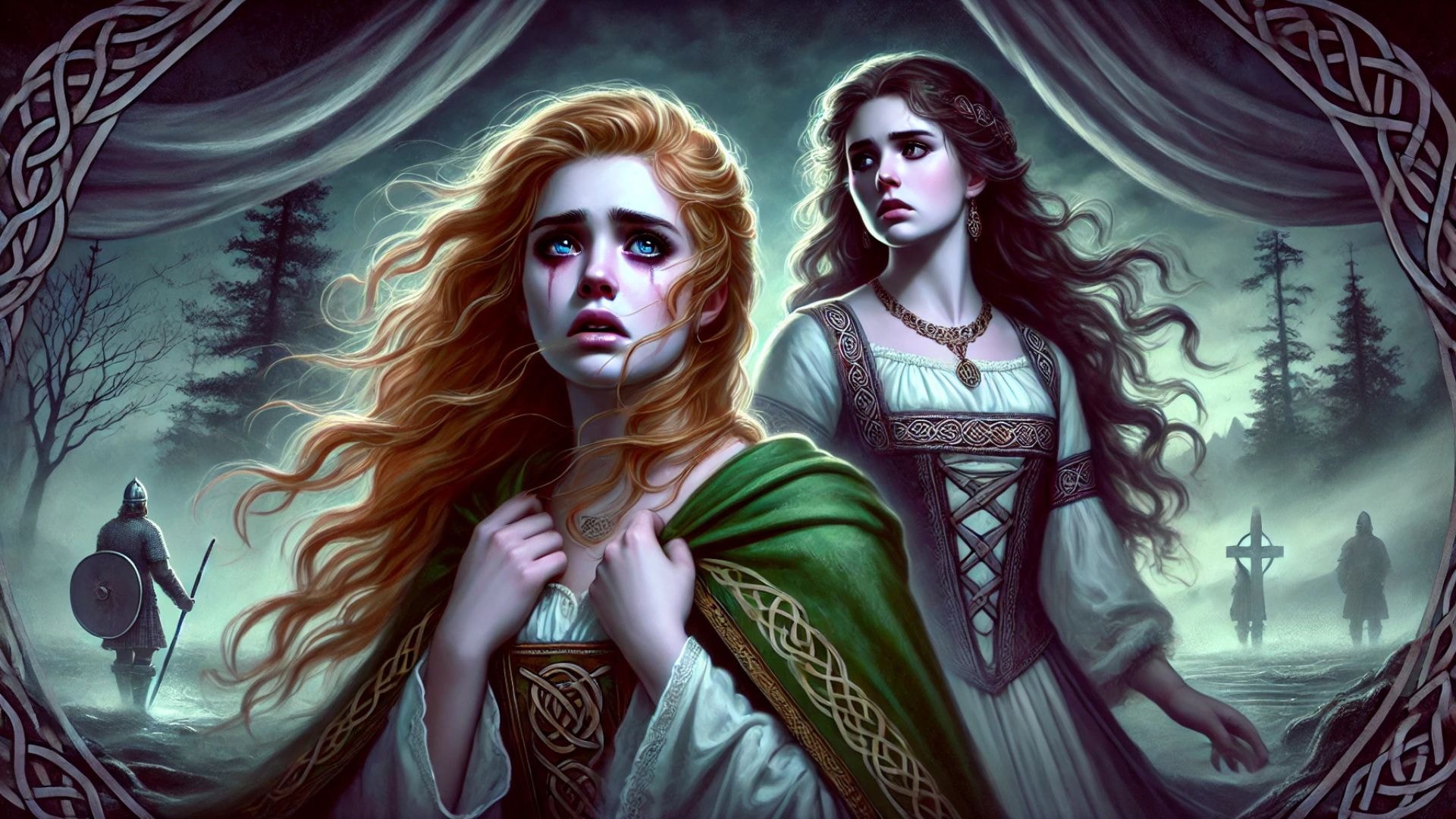
The tragic heroine of Irish mythology often represents a figure of immense beauty, strength, and sorrow. These women are central to many Irish legends, embodying the deep emotions and struggles of their time. Characters like Deirdre of the Sorrows, whose life was marked by love, betrayal, and tragedy, symbolize the themes of doomed fate and unrelenting sorrow that are woven throughout Celtic tales. Their stories reflect not only personal grief but also the larger conflicts of loyalty, honor, and destiny that shape Irish mythology.
What Defines a Tragic Heroine?
A tragic heroine embodies profound heroism intertwined with personal doom or downfall. She often grapples with insurmountable fate or makes a noble sacrifice. Such characters frequently engage in battles, endure betrayals, or suffer from forbidden loves. These heroines resonate through tales of courage and tragedy, leaving a lasting impact on folklore. Their stories underscore the tension between destiny and personal choice within the mythological narrative of Ireland.
Tragic Heroines in Irish Mythology
Tragic heroines in Irish mythology encapsulate the essence of dramatic sorrow and epic destinies. These figures often embody themes of love, betrayal, and inevitable fate, shaping the narratives of ancient Irish lore. Among the most poignant are Deirdre of the Sorrows and Gráinne, whose tales of passion and tragedy have been recounted across generations.
Their stories not only enrich the cultural tapestry of Ireland but also offer insights into the values and challenges of their times. Each heroine’s journey reflects the complex interplay between personal desire and societal expectations, marked by poignant choices and dramatic outcomes.
Story of Deirdre of the Sorrows
Deirdre of the Sorrows stands as one of the most poignant tragic heroines in Irish mythology. Born amidst prophecies of great beauty and great sorrow, her life was marked by dramatic twists of fate.
-
Prophecy and Birth: A druid prophesized that Deirdre would grow to be incredibly beautiful but would bring strife and ruin to the kingdom of Ulster. Despite this, she was raised in seclusion by a nursemaid, hidden from the world.
-
The Escape with Naoise: As she blossomed into a woman, Deirdre fell deeply in love with Naoise, a warrior and singer. Defying King Conchobar’s wishes, who desired her for himself, Deirdre fled with Naoise and his brothers to Scotland.
During their years in exile, Deirdre and Naoise lived a life filled with love, yet overshadowed by the threat of retribution. Their happiness was cut short when Conchobar deceitfully summoned them back to Ulster.
-
Betrayal and Tragedy: Upon their return, Conchobar's true intentions were revealed. He had Naoise killed, and Deirdre was forcibly taken as his wife. Overcome with grief and despair, Deirdre's life ended in tragedy—some versions say she died of a broken heart, while others tell of her taking her own life to escape Conchobar.
Deirdre's story is a powerful example of the tragic destiny shaped by beauty and sorrow, echoing through Irish lore as a poignant reminder of the personal costs of conflicts and desires.
Story of Grainne
Grainne, a tragic heroine of Irish mythology, embodies themes of love, betrayal, and fate. As the daughter of Cormac Mac Airt, the High King of Ireland, her story begins with a royal betrothal. Destined to marry the renowned warrior Fionn Mac Cumhaill, Grainne's life takes a dramatic turn during their engagement feast.
-
At the feast, Grainne meets Diarmuid, one of Fionn's most trusted warriors.
-
Struck by his beauty and valor, she falls deeply in love with him.
-
Unable to marry Fionn and desperate to be with Diarmuid, Grainne makes a fateful decision.
Using a magic potion, Grainne casts a love spell on Diarmuid. Compelled by the spell, he elopes with her, sparking a relentless chase across Ireland led by a spurned and vengeful Fionn. Their flight is marked by both romance and peril, illustrating the depth of Grainne's tragic character.
Grainne's story is a poignant narrative of conflict between duty and desire, showcasing the inevitable tragedy that ensues when personal happiness conflicts with societal obligations. Her tale remains a powerful example of the tragic heroine archetype in Irish mythology.
Cultural Significance of Tragic Heroines in Irish Lore
The tragic heroines of Irish lore hold deep cultural significance, symbolizing the nation's struggles, resilience, and emotional depth. These women, like Deirdre, Grainne, and Aoife, are central figures in Celtic mythology and embody the complexities of love, loyalty, and fate in Irish society. Deirdre's tragic tale, where she told Leabharcham, the wise old woman, of her doomed love for Naoise, unfolds within the Ulster Cycle, alongside the rule of King Conchobar and the betrayal by Éogan mac Durthacht. Their stories are often intertwined with themes of sacrifice, as they challenge societal norms, defy powerful rulers, or face tragic outcomes beyond their control. One might even find their tales referenced in a crossword clue, hinting at the deep influence of these legends in contemporary culture.
These heroines reflect the broader Irish experience of hardship and perseverance, acting as metaphors for the historical struggles of the Irish people. By embodying both strength and vulnerability, these figures resonate with cultural values of honor, personal sacrifice, and the pursuit of freedom, making them enduring symbols in Irish legend and mythology. Tales like Deirdre’s love for a handsome young warrior echo through the ages, reminding us of the enduring power of these narratives.
-
Symbolism: Tragic heroines symbolize the intersection of personal desire and the harsh realities of fate. Their stories are cautionary tales that warn of the dangers of unchecked ambition and passion.
-
Cultural Identity: Through these narratives, Irish lore communicates crucial aspects of its cultural ethos, such as the importance of loyalty and the tragic beauty of sacrifice.
-
Literary Influence: These characters have significantly influenced Irish literature, inspiring poets and playwrights from the Celtic Revival to contemporary times.
Thus, tragic heroines in Irish mythology are not just stories from the past; they continue to influence Irish identity and artistic expression today.
Lessons from the Tragic Heroines of Irish Mythology
The tragic heroines of Irish mythology teach timeless lessons about love, sacrifice, and the complexities of fate. Figures such as Deirdre of the Sorrows, who, as Deirdre told Leabharcham, foresaw the heartbreak her love would bring, and Gráinne demonstrate the consequences of passion and defiance in a world governed by honor and duty. Their stories remind us that personal desires often clash with societal expectations, leading to heartache and tragedy.
Yet, their unwavering courage and determination also reflect the strength of the human spirit in the face of adversity. Through their struggles, these heroines offer insights into the themes of loyalty, the cost of freedom, and the inevitability of fate, which continue to resonate with modern audiences.
-
Destiny is Inescapable: Just as Deirdre's fate was sealed by prophecy, we learn the power of destiny over personal will.
-
Strength in Adversity: Tragic heroines demonstrate resilience in the face of unavoidable misfortune, showing that inner strength is as significant as outer triumph.
-
The Dual Edges of Power: Queen Maeve’s pursuit of the Brown Bull of Cooley highlights how ambition can lead to both greatness and ruin.
FAQs On Tragic Heroine of Irish Mythology
1. Who is considered a tragic heroine in Irish mythology?
Deirdre of the Sorrows is recognized as a tragic heroine in Irish mythology. Her life was defined by prophecy and tragedy.
2. What tragic event defines Deirdre in Irish legends?
Deirdre's forced separation from her love, Naoise, and her subsequent death, mark the tragic events of her legend.
3. Why is Deirdre’s story important in Irish folklore?
Deirdre's story is important in Irish folklore because it embodies themes of fate, sorrow, and the destructive power of beauty and love, reflecting the depth of Irish tragic storytelling.
4. How do modern interpretations of Deirdre's story vary?
Modern interpretations of Deirdre's story often focus on her strength and agency, exploring her as a symbol of resistance against the destiny imposed on her.
5. Can Deirdre’s tale be linked to any historical events in Ireland?
While Deirdre’s tale is mythological, its themes of division and tragedy echo the historical struggles and conflicts throughout Ireland's history, symbolizing broader cultural sorrows.
